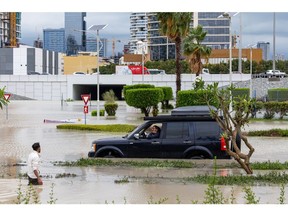Article content
(Bloomberg) — Dubai, the Middle Eastern financial hub, has been buffeted by humidity and heat waves that’s already caused temperatures to feel higher than 60C (140F) several days this summer.
On July 20, for example, temperatures hit a high of 42C at Dubai International Airport, according to data from the US National Weather Service. However, intense humidity that day compounded the heat to make it feel like more than 62C, according to the weather service’s heat index, which combines both metrics to express how the temperature feels to the human body.
Article content
The US weather service says such heat poses “extreme danger” to humans because heat stroke is likely. Though humidity has eased in the last few days, the searing temperatures in the desert city come as the Middle East heats up at one of the fastest paces in the world.
More than 1,300 pilgrims died at the annual Hajj gathering in Saudi Arabia amid soaring heat this year, which has also hit agriculture in Egypt and closed offices in Iran. Dubai has already suffered the fallouts of extreme weather in April this year, with record rains lashing the city and leaving homes and highways flooded for days.
Read: How Extreme Heat and Humidity Test Survival Limits: QuickTake
This summer the feels-like temperature in Dubai has already surpassed 60C on five days, compared with just one last year and none in 2022, according to the US National Weather Service data. The threshold for “extreme danger” to health — above 54C — has been breached on 13 days this year, compared with 23 days in 2023 and seven the previous year.
Extreme weather conditions are hitting many parts of the world with greater frequency and force as a consequence of climate change and rapid urbanization with countries from Canada to Greece feeling the effects. Yet the Middle East is particularly susceptible because of its desert landscape and proximity to the Persian Gulf.
Article content
Also read: Dubai Flooding Was Up to 40% More Intense Due to Climate Change
Climate change is becoming a long-term threat to cities in the region as they expand. According to projections from the Intergovernmental Panel on Climate Change, the Middle East will see temperatures rise 1.3C by the end of the century under an optimistic scenario and by 4.7C under a pessimistic scenario.
“This will be life-threatening for humans, and even high-temperature tolerant animals such as camels cannot survive in such conditions,” scientists based in the region and beyond said in a paper in Nature’s npj Climate and Atmospheric Science journal.
Representatives of the UAE’s Ministry of Climate Change & Environment didn’t respond to emailed requests for comments. Calls to the ministry’s Dubai and Abu Dhabi offices weren’t answered.
Persian Gulf Waters
The Persian Gulf becomes the world’s hottest sea in the summer, with temperatures regularly exceeding 36C in the shallow waters near the UAE. As a whole, the Gulf is warming at over twice the rate of the world’s oceans and marine heat waves are becoming more frequent and severe.
Article content
Caught between the hot desert air and humidity from the sea, coastal regions take the brunt of the impact. Cities face the added challenge of the so-called urban heat island effect. Built-up areas are often 3-4C hotter than rural.
The Middle East as a whole is warming at a rate of 0.45C per decade, 1.66 times higher than the global average. The elderly and very young are at particular risk of heat-related illnesses, as well as those with preexisting conditions such as cardiovascular and respiratory diseases and diabetes.
Also, for those who work outside, staying indoors isn’t an option. Hotter conditions can be deadly and highlight entrenched inequalities along socio-economic and ethnic lines in the Gulf countries. White collar workers that spend their days indoors and those with easy access to expensive cooling are able to navigate the impacts of the weather far more easily.
—With assistance from Omar Tamo.
Share this article in your social network

